A Deep Learning Approach to Assist in Pottery Reconstruction from Its Sherds
Abstract
1. Introduction
2. Related Works
3. Materials
4. Proposed Method
4.1. Problem Modeling
4.1.1. Normalized Cloud
4.1.2. Canonical Cloud
4.1.3. Target Euclidean Transformation
4.2. PotNet Model
4.3. Training Procedure
5. Experimental Setup
5.1. Virtual Shattering Procedure
5.2. Synthetic Sherd Datasets
5.3. Training
5.4. Computational Environment and Requirements
6. Results and Discussion
6.1. Results for the Synthetic Test Bset
6.2. Results for the Real-World Test Set
7. Conclusions
Author Contributions
Funding
Data Availability Statement
Acknowledgments
Conflicts of Interest
Abbreviations
| DGCNN | Dynamic Graph Convolutional Neural Network |
| ICP | Iterative Closest Point |
| LV | Large Vessel |
| MV | Medium Vessel |
| POCO | Point Cloud-Based Object Classification and Orientation |
| RMSE | Root Mean Square Error |
| STD | Standard deviation |
| SV | Small Vessel |
| SVD | Singular Value Decomposition |
| 1 | Here, we use the right-handed coordinate system as our reference coordinate system with the y axis pointing up, coinciding with the rotation axis. |
References
- Lee, S.; Yang, Y. Progressive Deep Learning Framework for Recognizing 3D Orientations and Object Class Based on Point Cloud Representation. Sensors 2021, 21, 6108. [Google Scholar] [CrossRef] [PubMed]
- Qi, C.R.; Su, H.; Mo, K.; Guibas, L.J. Pointnet: Deep learning on point sets for 3D classification and segmentation. In Proceedings of the IEEE Conference on Computer Vision and Pattern Recognition, Honolulu, HI, USA, 21–26 July 2017; pp. 652–660. [Google Scholar]
- Di Angelo, L.; Di Stefano, P.; Pane, C. An automatic method for pottery fragments analysis. Measurement 2018, 128, 138–148. [Google Scholar] [CrossRef]
- Rasheed, N.A.; Nordin, M.J. Classification and reconstruction algorithms for the archaeological fragments. J. King Saud Univ.-Comput. Inf. Sci. 2020, 32, 883–894. [Google Scholar] [CrossRef]
- Alagrami, A.; Palmieri, L.; Aslan, S.; Pelillo, M.; Vascon, S. Reassembling Broken Objects Using Breaking Curves. In Pattern Recognition; Antonacopoulos, A., Chaudhuri, S., Chellappa, R., Liu, C.L., Bhattacharya, S., Pal, U., Eds.; Springer: Cham, Switzerland, 2025; pp. 197–208. [Google Scholar]
- Eslami, D.; Di Angelo, L.; Di Stefano, P.; Pane, C. Review of computer-based methods for archaeological ceramic sherds reconstruction. Virtual Archaeol. Rev. 2020, 11, 34–49. [Google Scholar] [CrossRef]
- Di Angelo, L.; Di Stefano, P.; Guardiani, E. A review of computer-based methods for classification and reconstruction of 3D high-density scanned archaeological pottery. J. Cult. Herit. 2022, 56, 10–24. [Google Scholar] [CrossRef]
- Papaioannou, G.; Karabassi, E.A.; Theoharis, T. Automatic Reconstruction of Archaeological Finds—A Graphics Approach. In Proceedings of the 4th International Conference on Computer Graphics and Artificial Intelligence, Limoges, France, 3–4 March 2000; pp. 117–125. [Google Scholar]
- Cooper, D.B.; Willis, A.; Andrews, S.; Baker, J.; Cao, Y.; Han, D.; Kang, K.; Kong, W.; Leymarie, F.F.; Orriols, X.; et al. Assembling virtual pots from 3D measurements of their fragments. In Proceedings of the 2001 Conference on Virtual Reality, Archeology, and Cultural Heritage, Glyfada, Greece, 28–30 November 2001; pp. 241–254. [Google Scholar]
- Andrews, S.; Laidlaw, D.H. Toward a framework for assembling broken pottery vessels. In Proceedings of the Eighteenth National Conference on Artificial Intelligence (AAAI/IAAI), Edmonton, AB, Canada, 28 July–1 August 2002; pp. 945–946. [Google Scholar]
- Kampel, M.; Sablatnig, R. 3D puzzling of archeological fragments. In Proceedings of the 9th Computer Vision Winter Workshop, Piran, Slowenien, 4–6 February 2004; Volume 2, pp. 31–40. [Google Scholar]
- Marie, I.; Qasrawi, H. Virtual assembly of pottery fragments using moiré surface profile measurements. J. Archaeol. Sci. 2005, 32, 1527–1533. [Google Scholar] [CrossRef]
- Huang, Q.X.; Flöry, S.; Gelfand, N.; Hofer, M.; Pottmann, H. Reassembling fractured objects by geometric matching. In ACM SIGGRAPH 2006 Papers; Association for Computing Machinery: Boston, MA, USA, 2006; pp. 569–578. [Google Scholar]
- Palmas, G.; Pietroni, N.; Cignoni, P.; Scopigno, R. A computer-assisted constraint-based system for assembling fragmented objects. In Proceedings of the 2013 Digital Heritage International Congress (DigitalHeritage), Marseille, France, 28 October–1 November 2013; Volume 1, pp. 529–536. [Google Scholar]
- Zheng, S.; Huang, R.; Li, J.; Wang, Z. Reassembling 3D thin fragments of unknown geometry in cultural heritage. ISPRS Ann. Photogramm. Remote Sens. Spat. Inf. Sci. 2014, 2, 393–399. [Google Scholar] [CrossRef]
- Stamatopoulos, M.I.; Anagnostopoulos, C.N. 3D digital reassembling of archaeological ceramic pottery fragments based on their thickness profile. arXiv 2016, arXiv:1601.05824. [Google Scholar]
- Cohen, F.; Zhang, Z.; Liu, Z. Mending broken vessels a fusion between color markings and anchor points on surface breaks. Multimed. Tools Appl. 2016, 75, 3709–3732. [Google Scholar] [CrossRef]
- Sakpere, W. 3D Reconstruction of Archaeological Pottery from Its Point Cloud. In Pattern Recognition and Image Analysis, Proceedings of the 9th Iberian Conference, IbPRIA 2019, Madrid, Spain, 1–4 July 2019; Proceedings, Part I 9; Springer: Cham, Switzerland, 2019; pp. 125–136. [Google Scholar]
- Eslami, D.; Di Angelo, L.; Di Stefano, P.; Guardiani, E. A semi-automatic reconstruction of archaeological pottery fragments from 2D images using wavelet transformation. Heritage 2021, 4, 76–90. [Google Scholar] [CrossRef]
- Kashihara, K. An Intelligent Computer Assistance System for Artifact Restoration Based on Genetic Algorithms with Plane Image Features. Int. J. Comput. Intell. Appl. 2017, 16, 1750021:1–1750021:15. [Google Scholar] [CrossRef]
- Anichini, F.; Dershowitz, N.; Dubbini, N.; Gattiglia, G.; Itkin, B.; Wolf, L. The automatic recognition of ceramics from only one photo: The ArchAIDE app. J. Archaeol. Sci. Rep. 2021, 36, 102788. [Google Scholar] [CrossRef]
- Kim, K.; Hong, J.; Rhee, S.H.; Woo, S.S. Reconstructing the Past: Applying Deep Learning to Reconstruct Pottery from Thousands Shards. In Machine Learning and Knowledge Discovery in Databases, Proceedings of the Applied Data Science and Demo Track: European Conference, ECML PKDD 2020, Ghent, Belgium, 14–18 September 2020; Proceedings, Part V; Springer: Cham, Switzerland, 2021; pp. 36–51. [Google Scholar]
- Kaya, G.; Bilmenoglu, C. Accuracy of 14 intraoral scanners for the All-on-4 treatment concept: A comparative in vitro study. J. Adv. Prosthodont. 2022, 14, 388–398. [Google Scholar] [CrossRef] [PubMed]
- Straumann Group. Straumann Virtuo Vivo™. Available online: https://www.straumann.com/clearcorrect/br/pt/discover/virtuo-vivo.html (accessed on 11 March 2025).
- Blender Home Page. Available online: https://www.blender.org/community (accessed on 11 March 2025).
- Garland, M.; Heckbert, P.S. Surface simplification using quadric error metrics. In Proceedings of the 24th Annual Conference on Computer Graphics and Interactive Techniques (SIGGRAPH ’97), Los Angeles, CA, USA, 3–8 August 1997; pp. 209–216. [Google Scholar]
- Muntoni, A.; Cignoni, P. PyMeshLab. Available online: https://pymeshlab.readthedocs.io/en/latest (accessed on 11 March 2025).
- Zhou, Y.; Barnes, C.; Lu, J.; Yang, J.; Li, H. On the continuity of rotation representations in neural networks. In Proceedings of the IEEE/CVF Conference on Computer Vision and Pattern Recognition, Long Beach, CA, USA, 15–20 June 2019; pp. 5745–5753. [Google Scholar]
- Van Loan, C.F. Generalizing the singular value decomposition. SIAM J. Numer. Anal. 1976, 13, 76–83. [Google Scholar] [CrossRef]
- O’Rourke, J. Finding minimal enclosing boxes. Int. J. Comput. Inf. Sci. 1985, 14, 183–199. [Google Scholar] [CrossRef]
- Jylänki, J. An Exact Algorithm for Finding Minimum Oriented Bounding Boxes. 2015. Available online: http://clb.confined.space/minobb/minobb_jylanki_2015_06_01.pdf (accessed on 11 March 2025).
- Dawson-Haggerty, M. Trimesh. Available online: https://trimesh.org (accessed on 11 March 2025).
- Arun, K.S.; Huang, T.S.; Blostein, S.D. Least-squares fitting of two 3-D point sets. IEEE Trans. Pattern Anal. Mach. Intell. 1987, PAMI-9, 698–700. [Google Scholar] [CrossRef] [PubMed]
- Malischewski, S.; Schumann, H.; Hoffmann, D. Kabsch Algorithm. Available online: https://biomolecularstructures.readthedocs.io/en/latest/kabsch (accessed on 25 July 2022).
- Ronnegren, J. Real Time Mesh Fracturing Using 2D Voronoi Diagrams. 2020. Available online: http://www.diva-portal.org/smash/record.jsf?pid=diva2:1452512 (accessed on 25 July 2022).
- Mark, d.B.; Otfried, C.; Marc, v.K.; Mark, O. Computational Geometry: Algorithms and Applications; Spinger: Berlin/Heidelberg, Germany, 2008. [Google Scholar]
- Corsini, M.; Cignoni, P.; Scopigno, R. Efficient and flexible sampling with blue noise properties of triangular meshes. IEEE Trans. Vis. Comput. Graph. 2012, 18, 914–924. [Google Scholar] [CrossRef] [PubMed]
- Kingma, D.P.; Ba, J. Adam: A method for stochastic optimization. arXiv 2014, arXiv:1412.6980. [Google Scholar]
- Ruder, S. An overview of gradient descent optimization algorithms. arXiv 2016, arXiv:1609.04747. [Google Scholar]
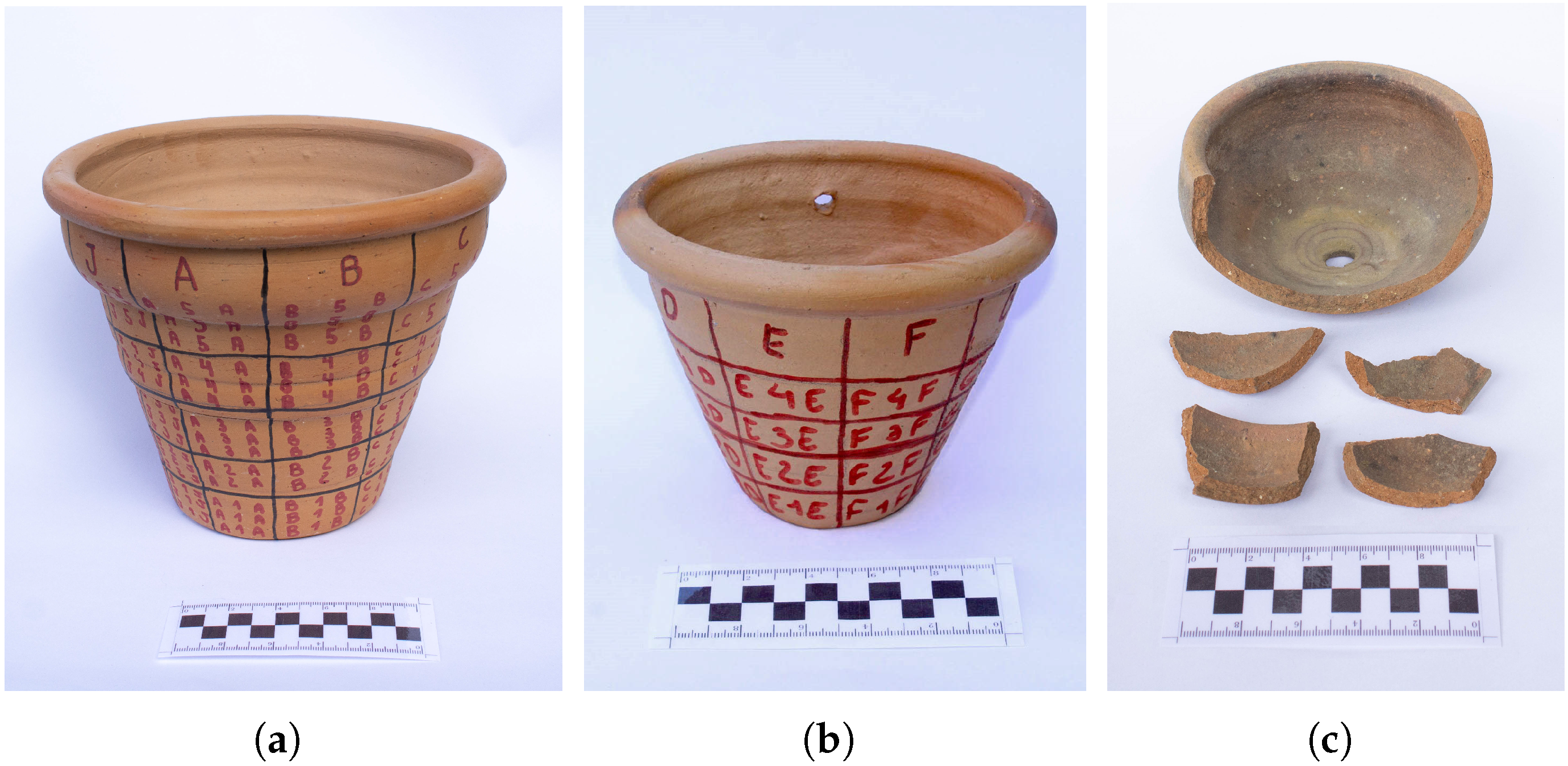

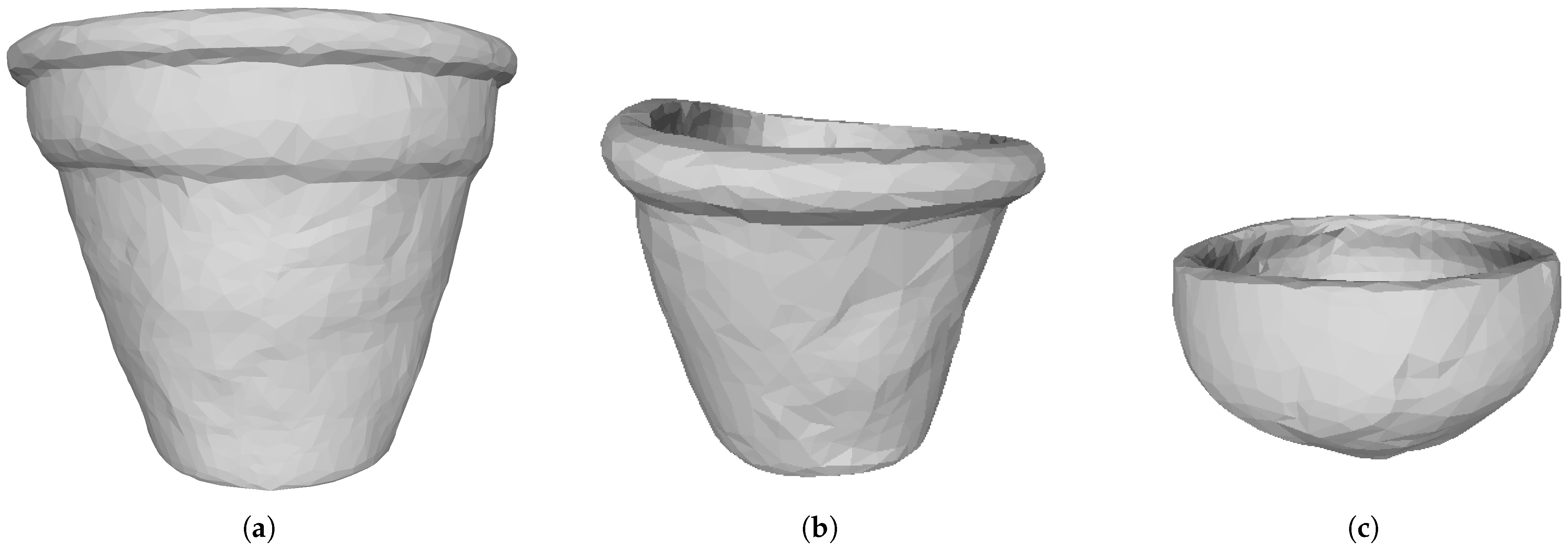
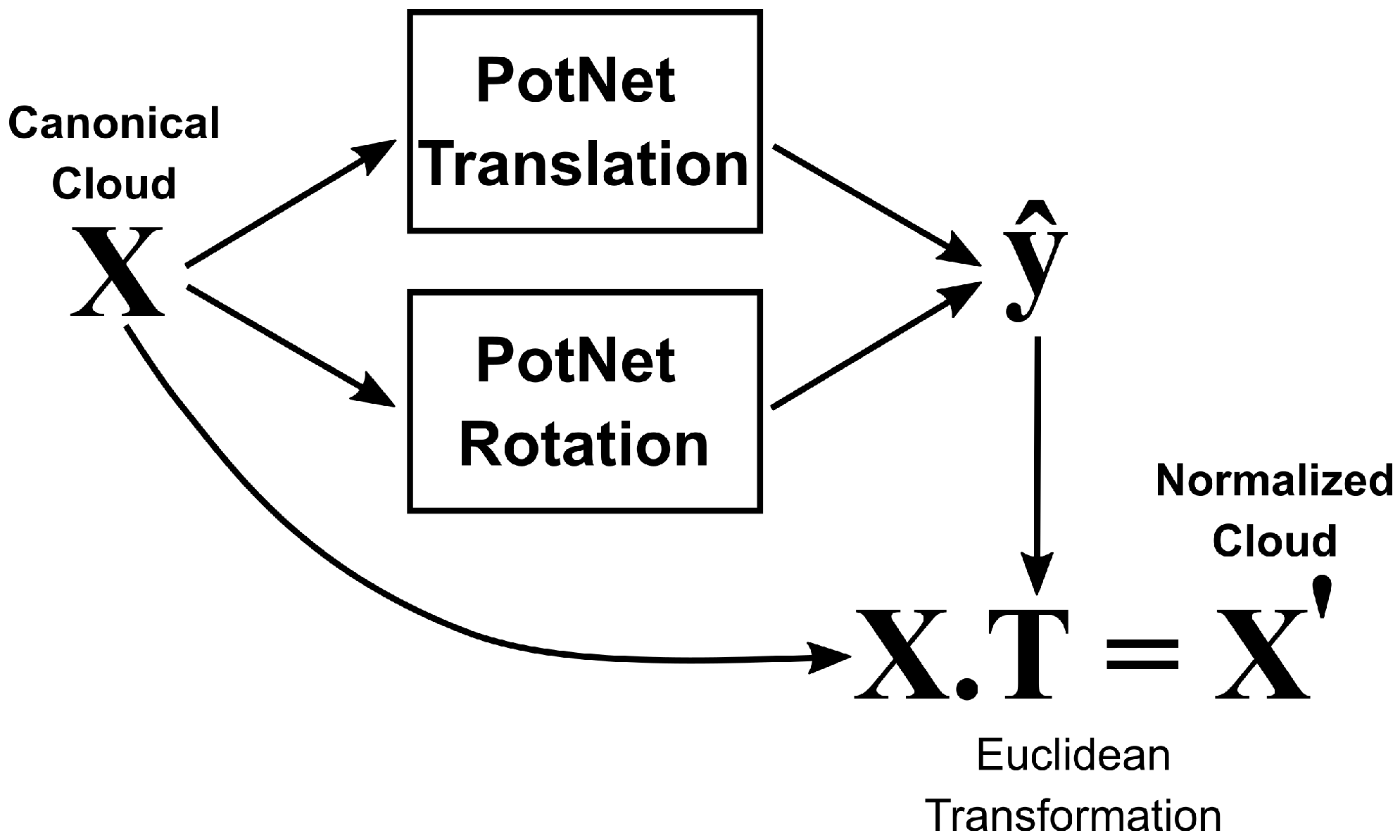
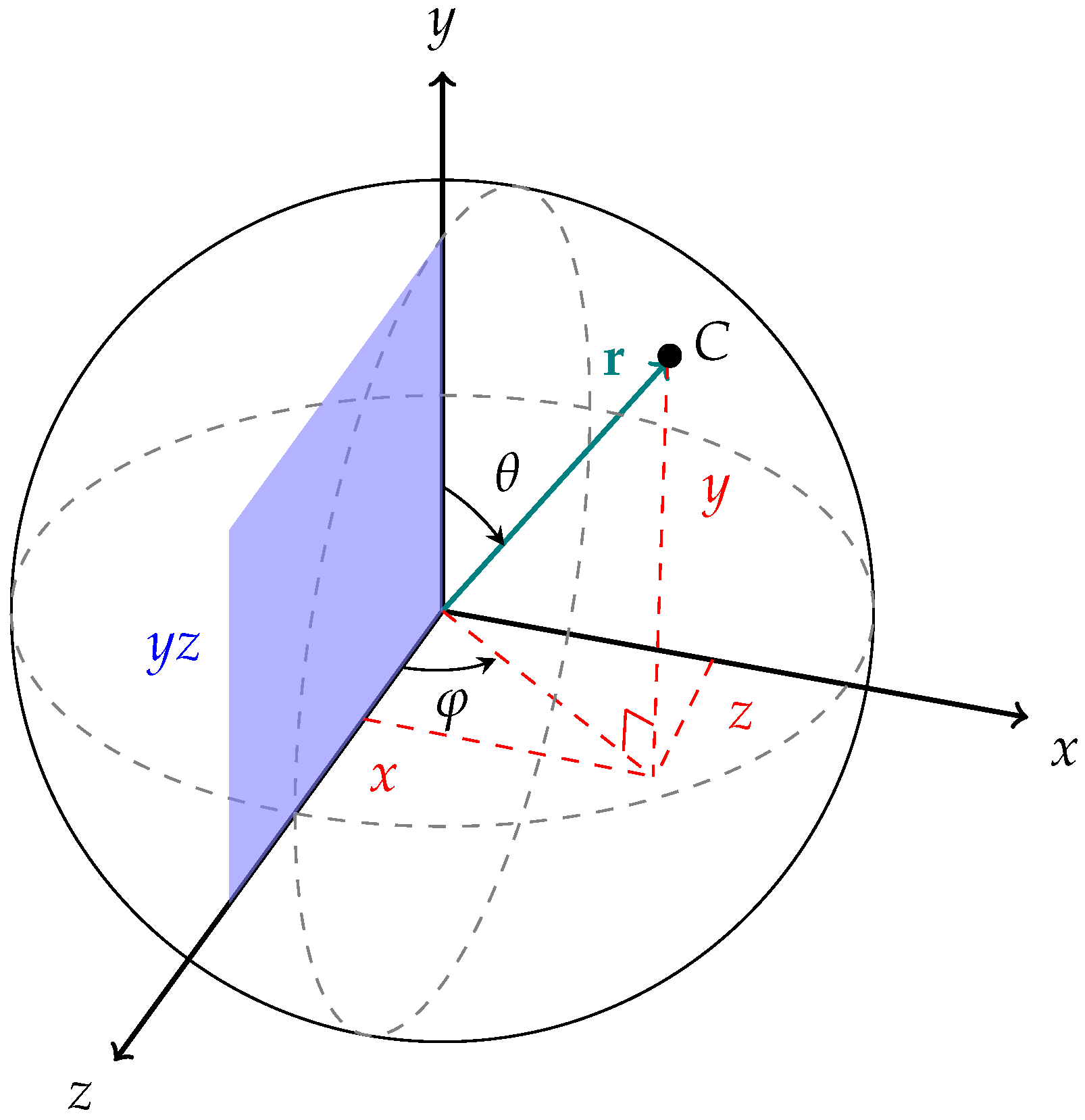
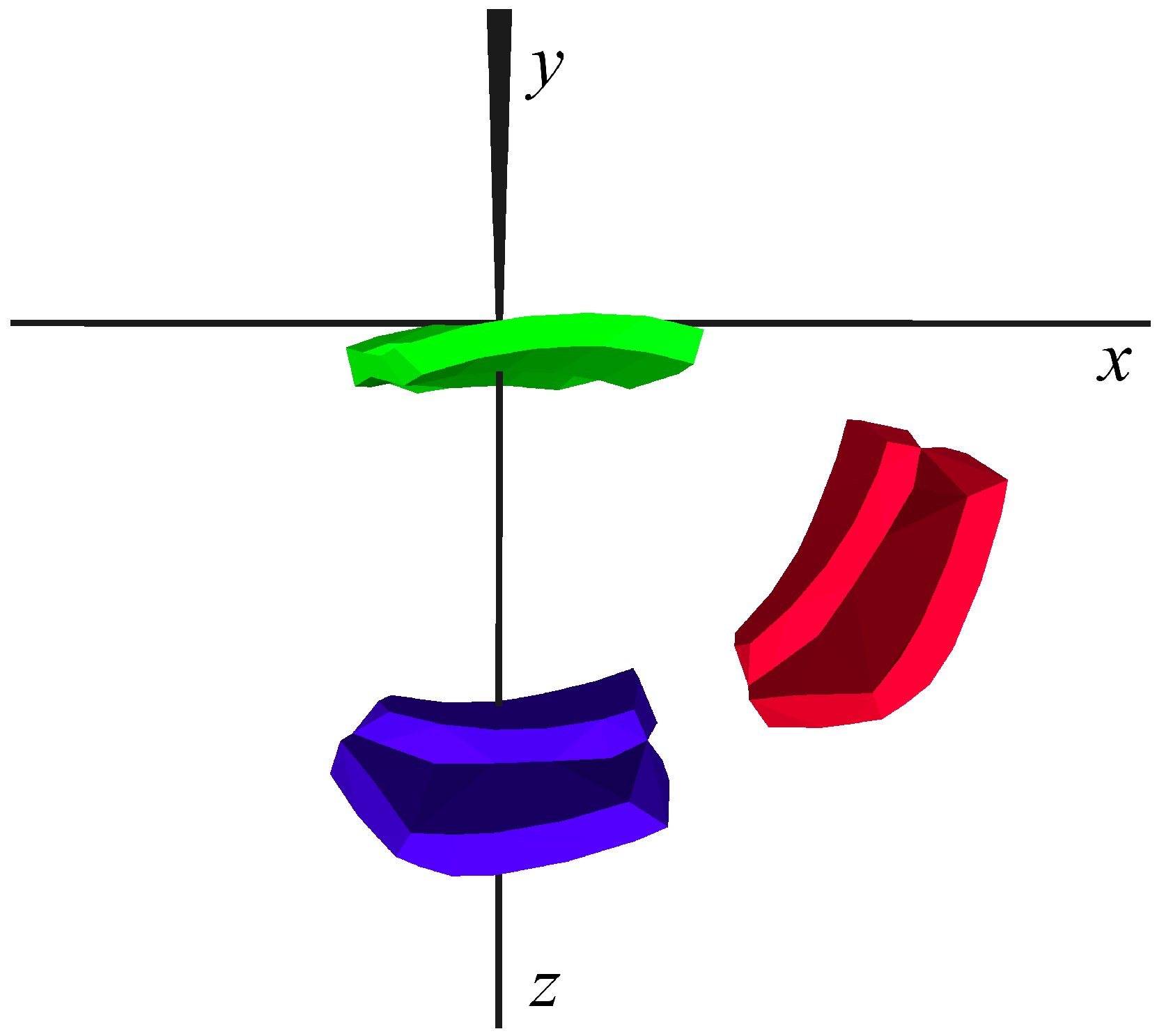
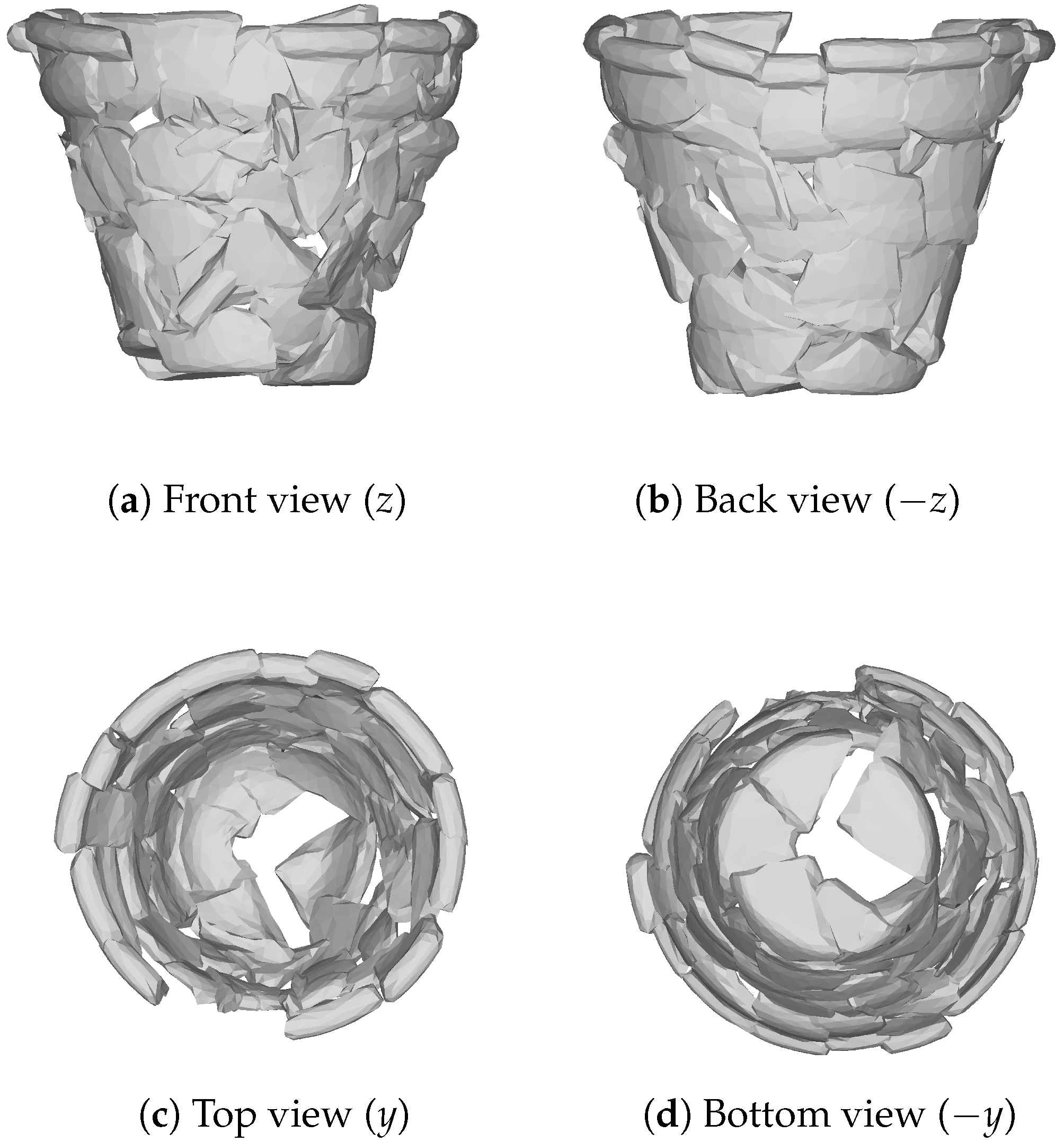

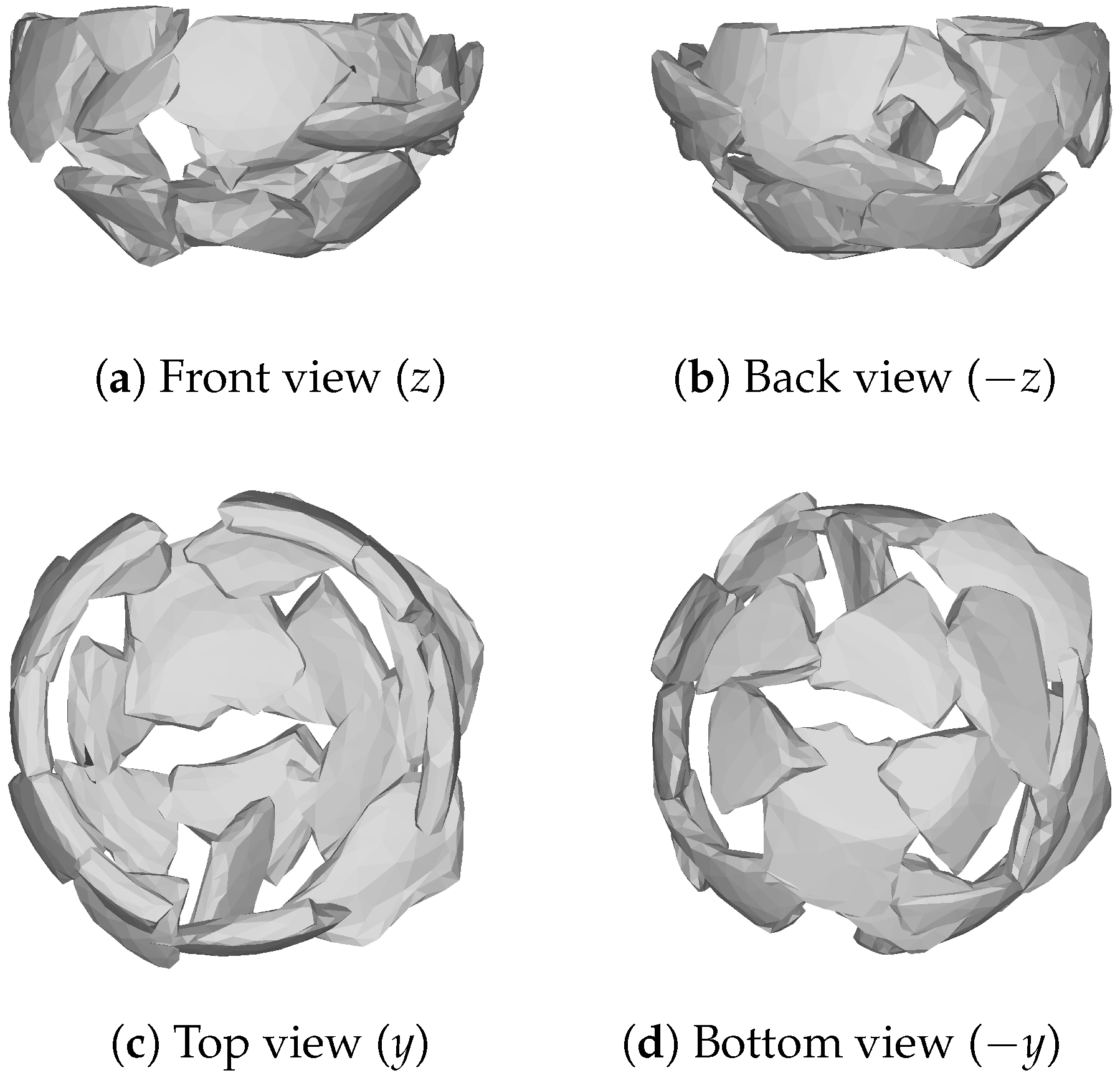
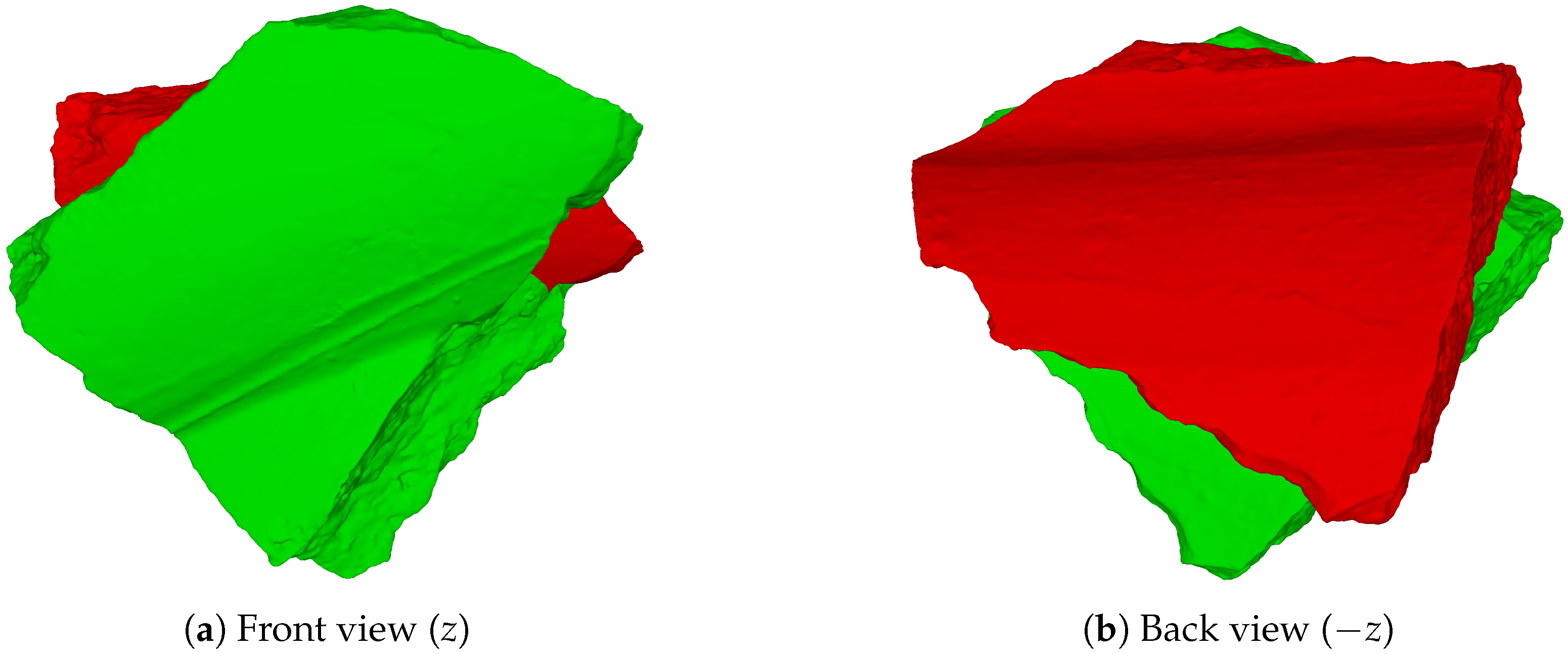
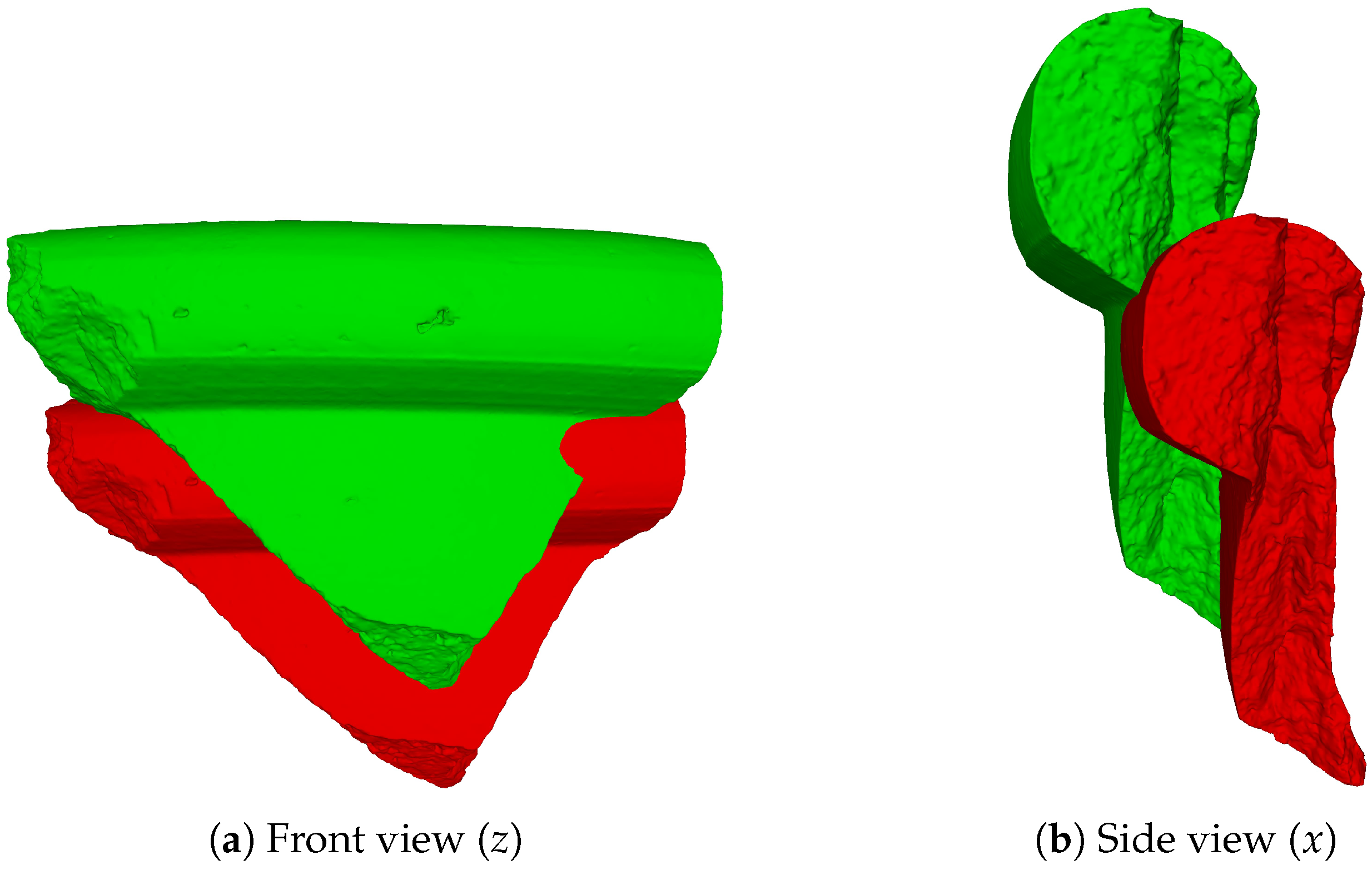
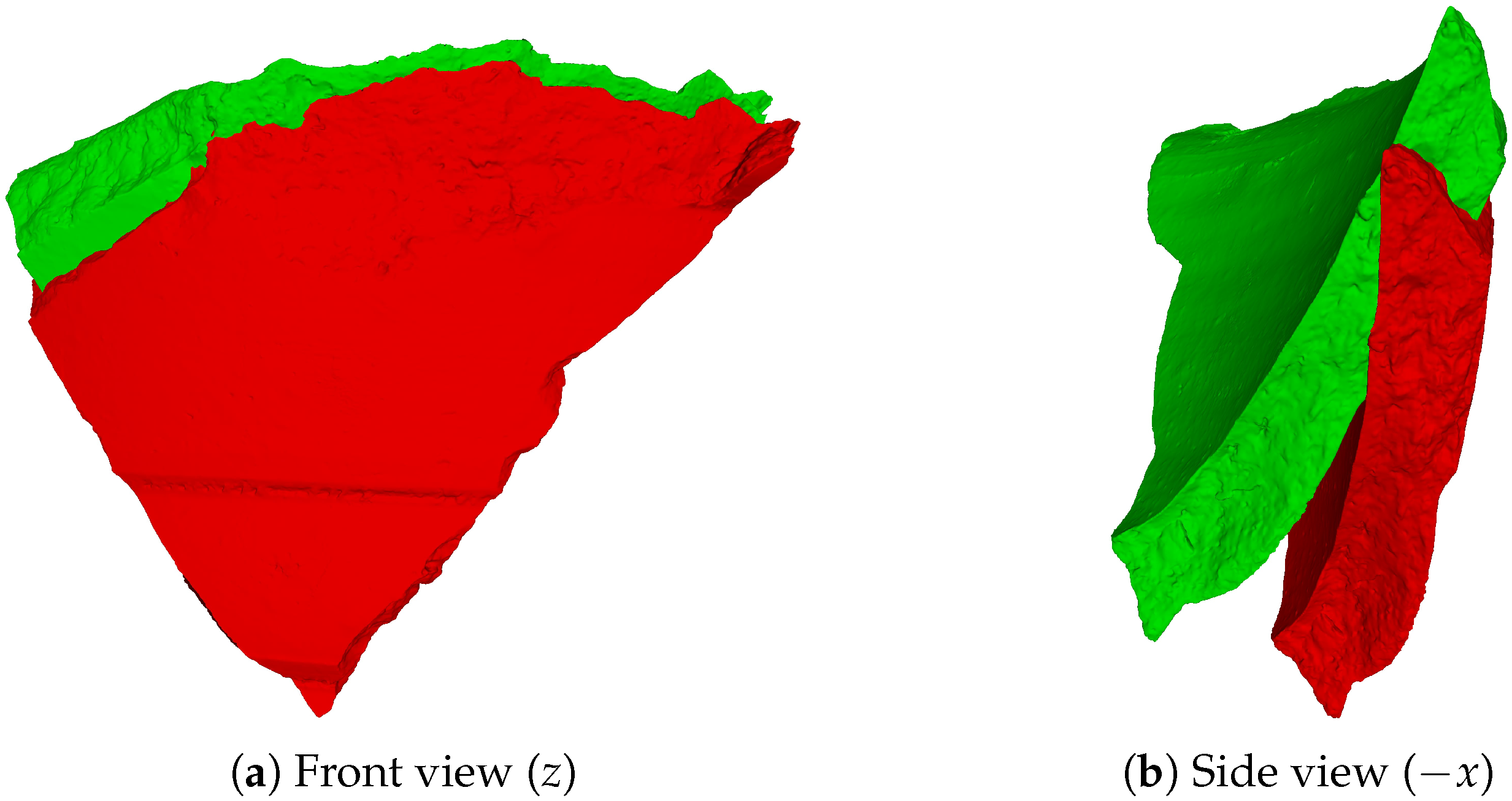
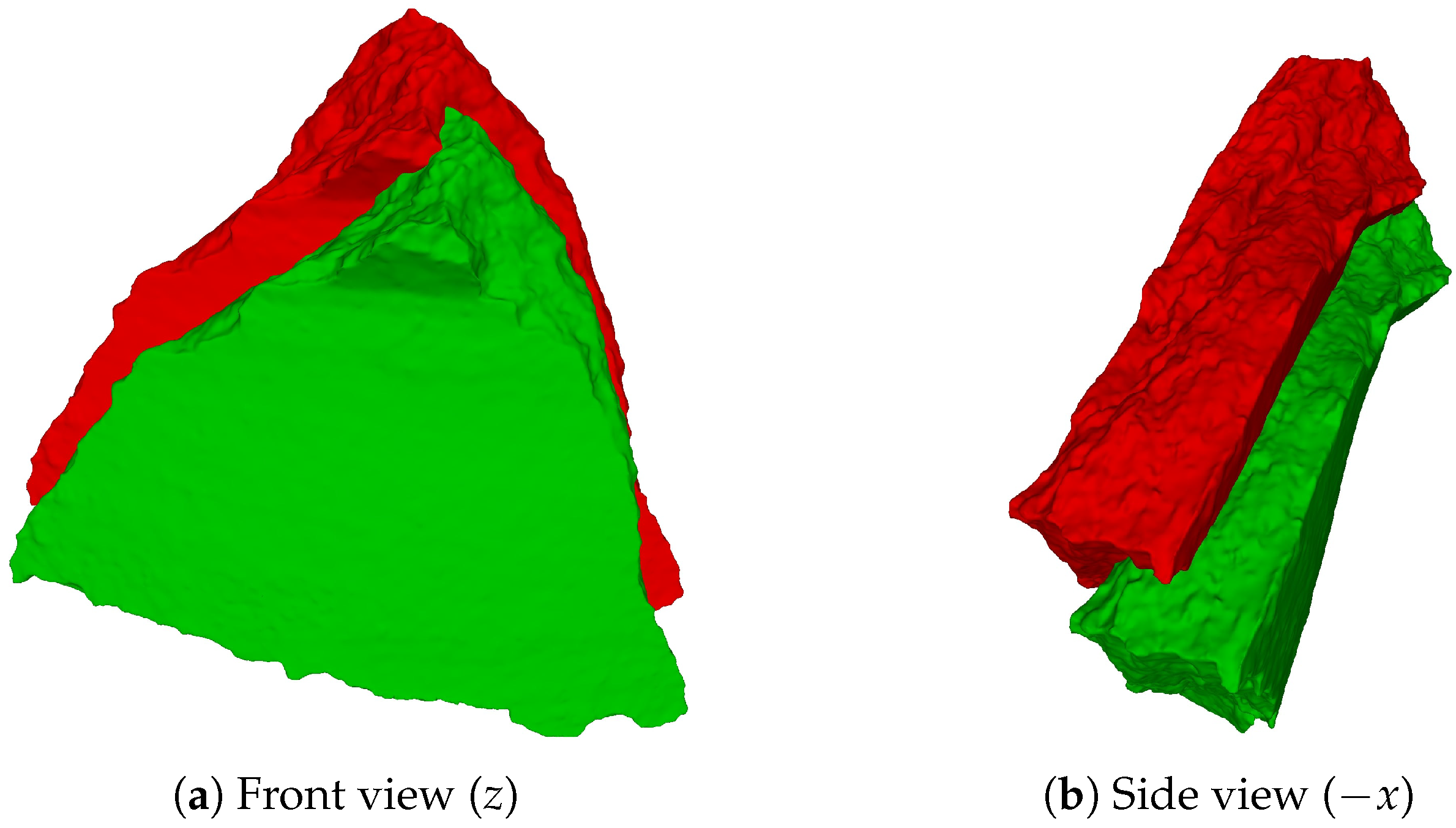
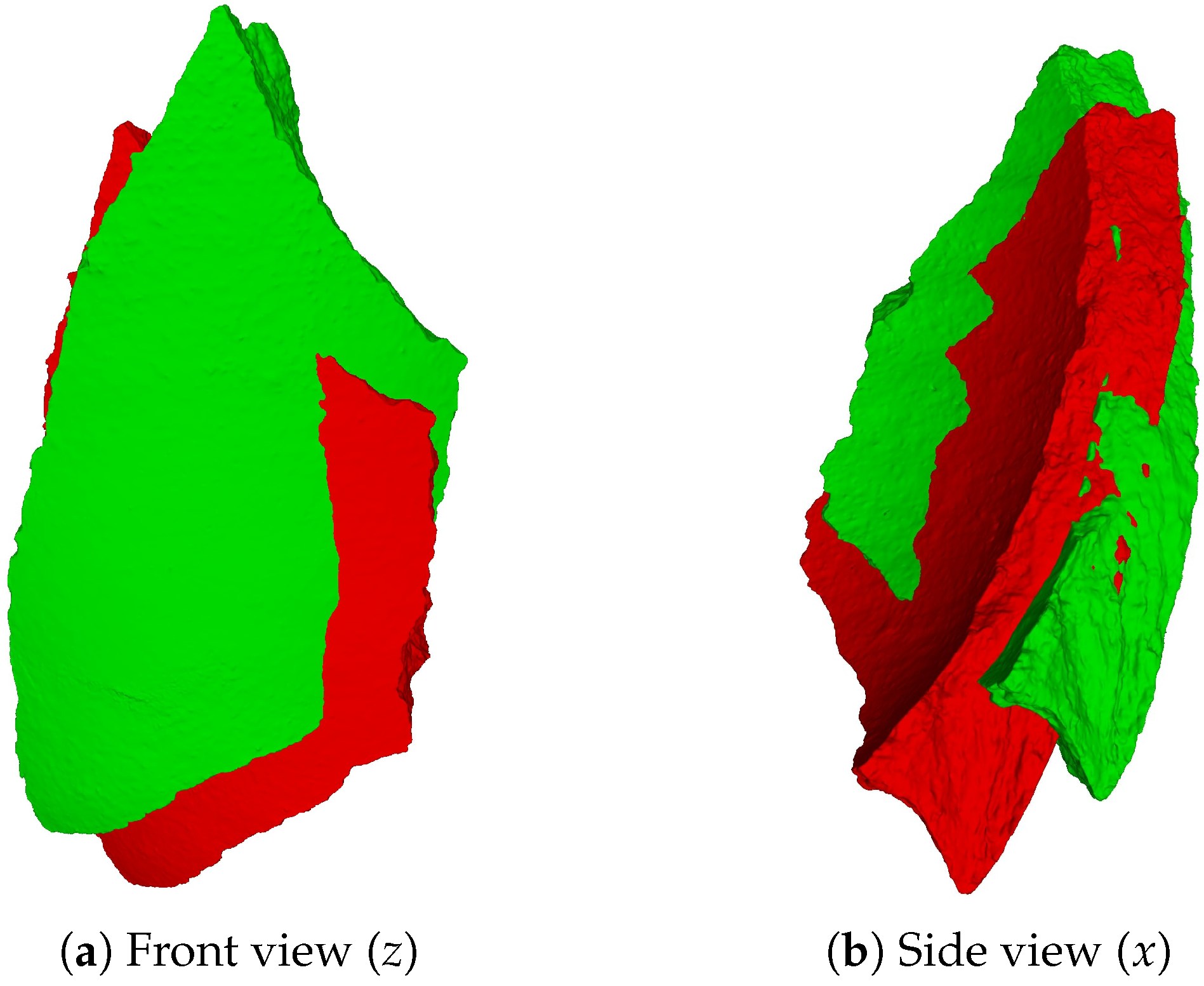
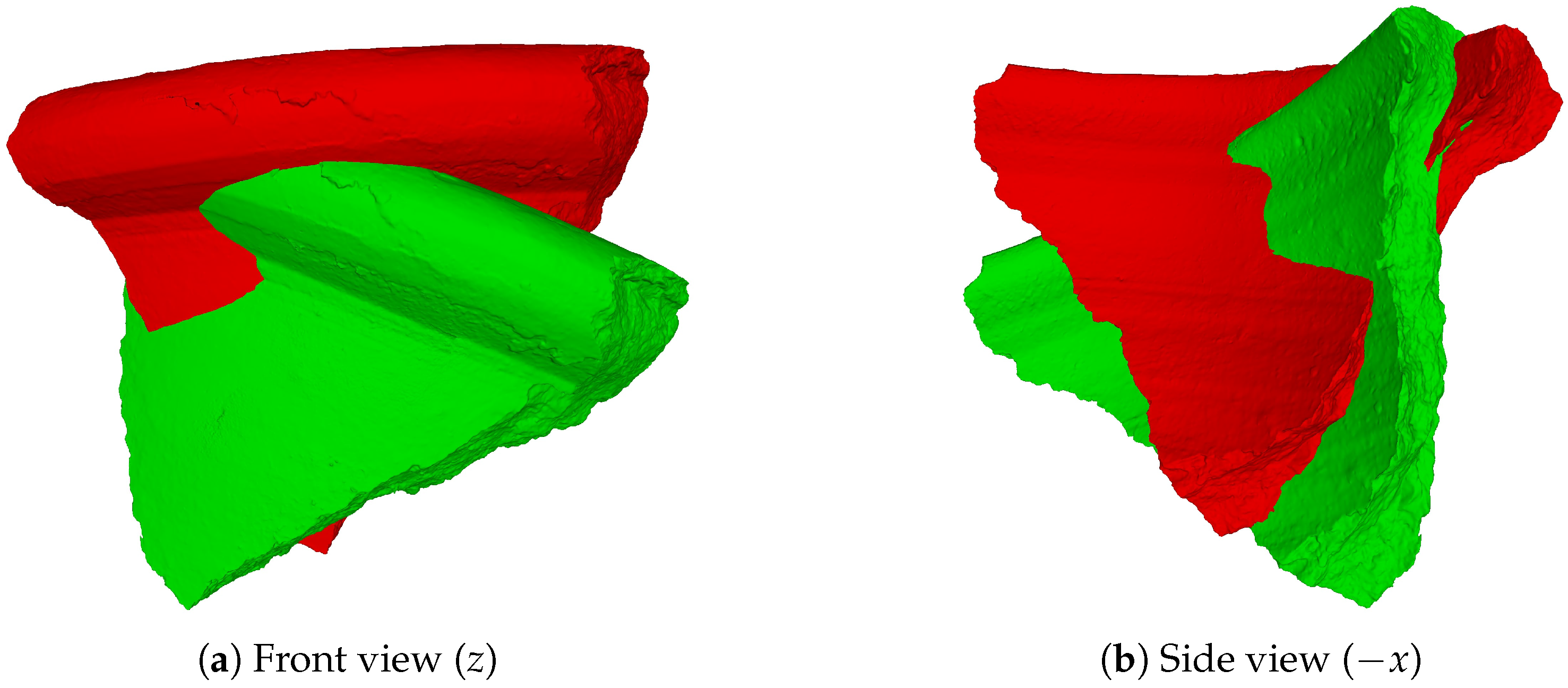
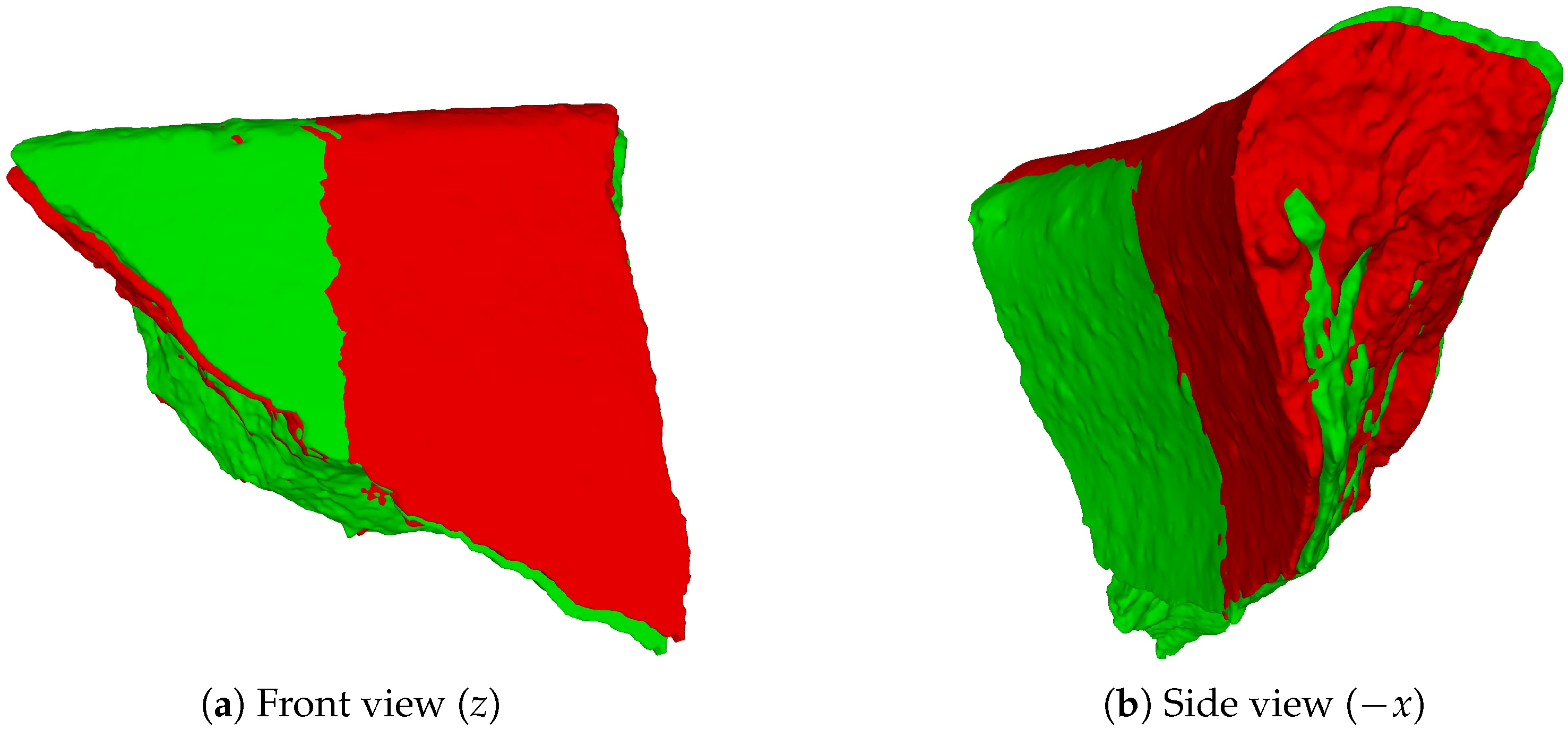
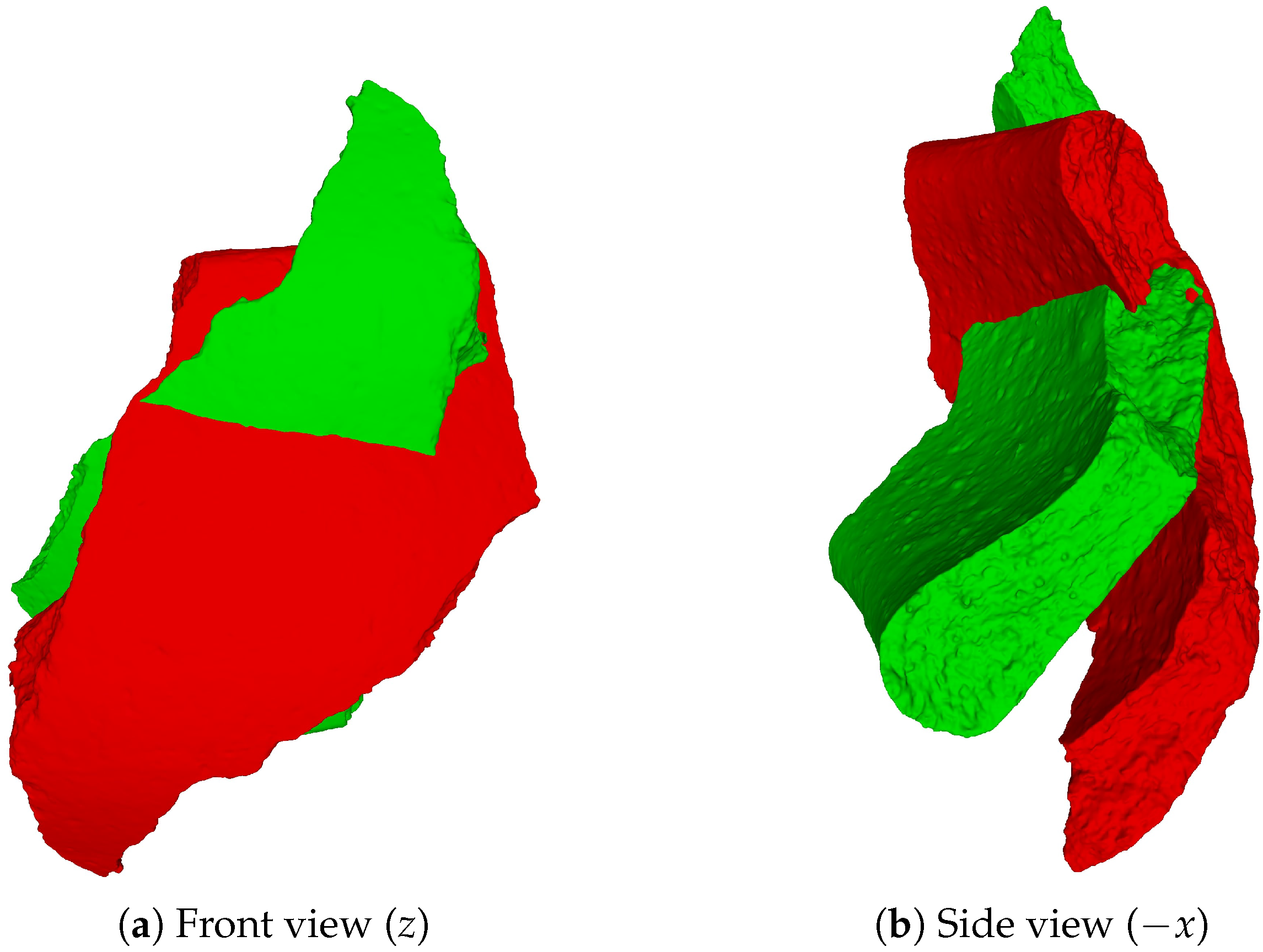

| Layer Type | Output Shape | Parameters |
|---|---|---|
| Input | 3 | 0 |
| Conv 1D 1 × 3/64 + ReLU | 64 | 256 |
| Conv 1D 1 × 64/64 + ReLU | 64 | 4160 |
| Conv 1D 1 × 64/64 + ReLU | 64 | 4160 |
| Conv 1D 1 × 64/128 + ReLU | 128 | 8320 |
| Conv 1D 1 × 128/1024 + ReLU | 1024 | 132,096 |
| Global Max Pooling 1D | M | 0 |
| Dense 512 | 512 | |
| Batch Normalization | 512 | 2048 |
| ReLU | 512 | 0 |
| Dense 256 | 256 | 131,328 |
| Batch Normalization | 256 | 1024 |
| ReLU | 256 | 0 |
| Dropout | 256 | 0 |
| Dense N | N | |
| Linear | N | 0 |
| Vessel | Train | Test | Total |
|---|---|---|---|
| LV | 78,892 | 8695 | 87,587 |
| MV | 76,664 | 7816 | 84,480 |
| SV | 77,377 | 7694 | 85,071 |
| RMSE | RMSE (x, y, z) | STD | |
|---|---|---|---|
| LV | 0.025 | (0.01, 0.021, 0.009) | 0.001 |
| MV | 0.017 | (0.008, 0.014, 0.007) | 0.0004 |
| SV | 0.013 | (0.008, 0.009, 0.006) | 0.0002 |
| RMSE | RMSE (x, y, z) | STD | |
|---|---|---|---|
| LV | 0.034 | (0.009, 0.026, 0.017) | 0.0006 |
| MV | 0.019 | (0.007, 0.01, 0.012) | 0.0002 |
| SV | 0.023 | (0.01, 0.012, 0.013) | 0.0003 |
| Sherd | RMSE | RMSE (x, y, z) | STD | |
|---|---|---|---|---|
| LV29 | 0.023 | (0.013, 0.014, 0.013) | 0.0002 | |
| Best cases | MV11 | 0.017 | (0.012, 0.011, 0.005) | 0.0001 |
| SV14 | 0.019 | (0.013, 0.012, 0.006) | 0.0002 | |
| LV23 | 0.034 | (0.024, 0.021, 0.013) | 0.0005 | |
| Average cases | MV19 | 0.032 | (0.015, 0.025, 0.012) | 0.0005 |
| SV21 | 0.027 | (0.015, 0.02, 0.009) | 0.0004 | |
| LV21 | 0.038 | (0.026, 0.025, 0.012) | 0.0008 | |
| Worst cases | MV17 | 0.038 | (0.028, 0.023, 0.011) | 0.0008 |
| SV11 | 0.033 | (0.023, 0.022, 0.01) | 0.0006 |
Disclaimer/Publisher’s Note: The statements, opinions and data contained in all publications are solely those of the individual author(s) and contributor(s) and not of MDPI and/or the editor(s). MDPI and/or the editor(s) disclaim responsibility for any injury to people or property resulting from any ideas, methods, instructions or products referred to in the content. |
© 2025 by the authors. Licensee MDPI, Basel, Switzerland. This article is an open access article distributed under the terms and conditions of the Creative Commons Attribution (CC BY) license (https://creativecommons.org/licenses/by/4.0/).
Share and Cite
Pinho, M.F.C.; Mota, G.L.A.; da Costa, G.A.O.P. A Deep Learning Approach to Assist in Pottery Reconstruction from Its Sherds. Heritage 2025, 8, 167. https://doi.org/10.3390/heritage8050167
Pinho MFC, Mota GLA, da Costa GAOP. A Deep Learning Approach to Assist in Pottery Reconstruction from Its Sherds. Heritage. 2025; 8(5):167. https://doi.org/10.3390/heritage8050167
Chicago/Turabian StylePinho, Matheus Ferreira Coelho, Guilherme Lucio Abelha Mota, and Gilson Alexandre Ostwald Pedro da Costa. 2025. "A Deep Learning Approach to Assist in Pottery Reconstruction from Its Sherds" Heritage 8, no. 5: 167. https://doi.org/10.3390/heritage8050167
APA StylePinho, M. F. C., Mota, G. L. A., & da Costa, G. A. O. P. (2025). A Deep Learning Approach to Assist in Pottery Reconstruction from Its Sherds. Heritage, 8(5), 167. https://doi.org/10.3390/heritage8050167









